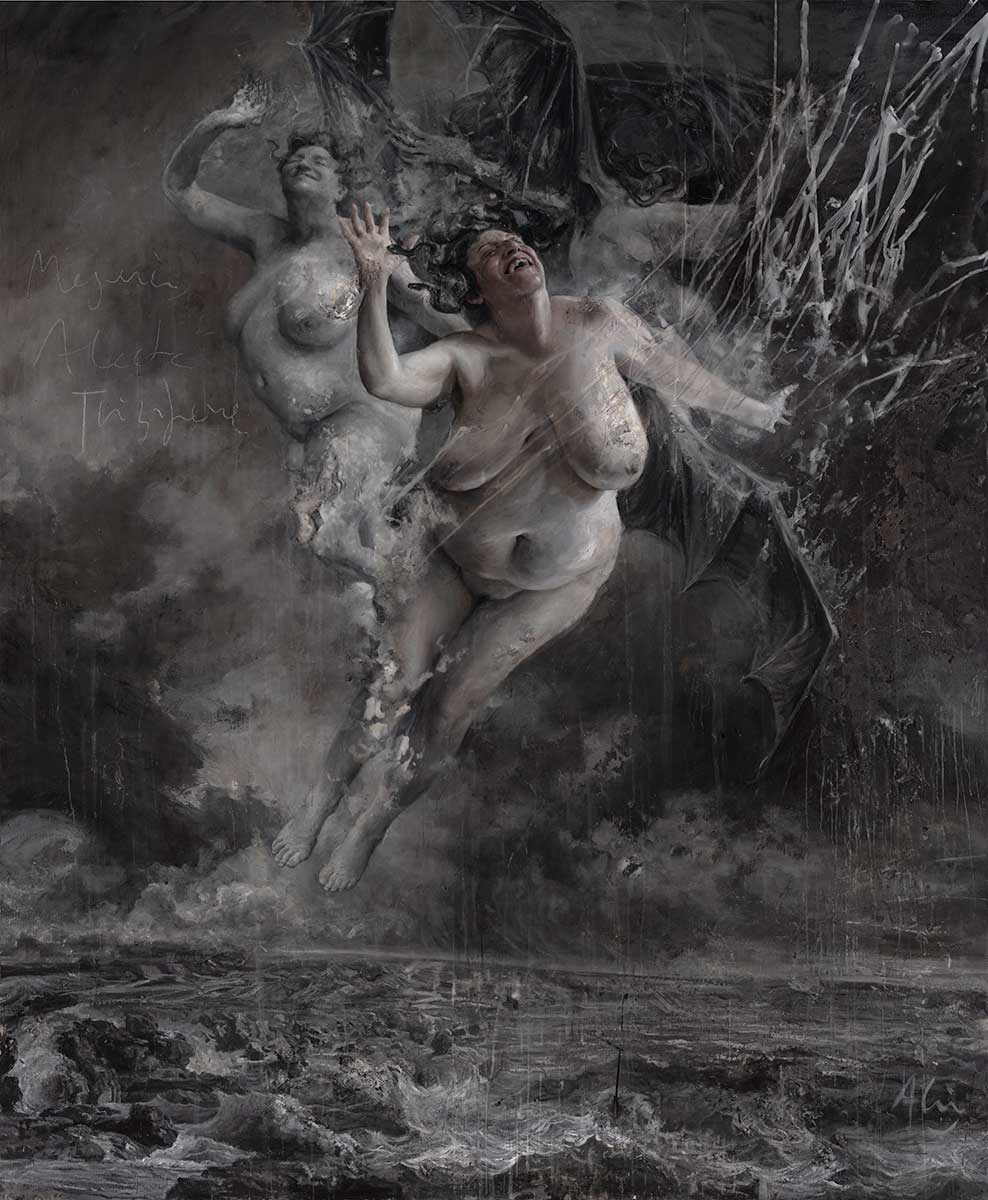The Mysterious Heroic World of Jordi Diaz Alamà
Artist/Painter | Director of The Barcelona Academy of Art
An Exclusive Interview by Ariel SU
“My inspiration primarily derives from literature and music, as they ignite my creativity. When I find myself deeply moved or captivated by a particular book or theme, I often plan a series of paintings around it. Working on multiple paintings simultaneously keeps my creative energy flowing and prevents monotony, allowing me to explore diverse aspects of the chosen theme.”
– Jordi Diaz Alamà

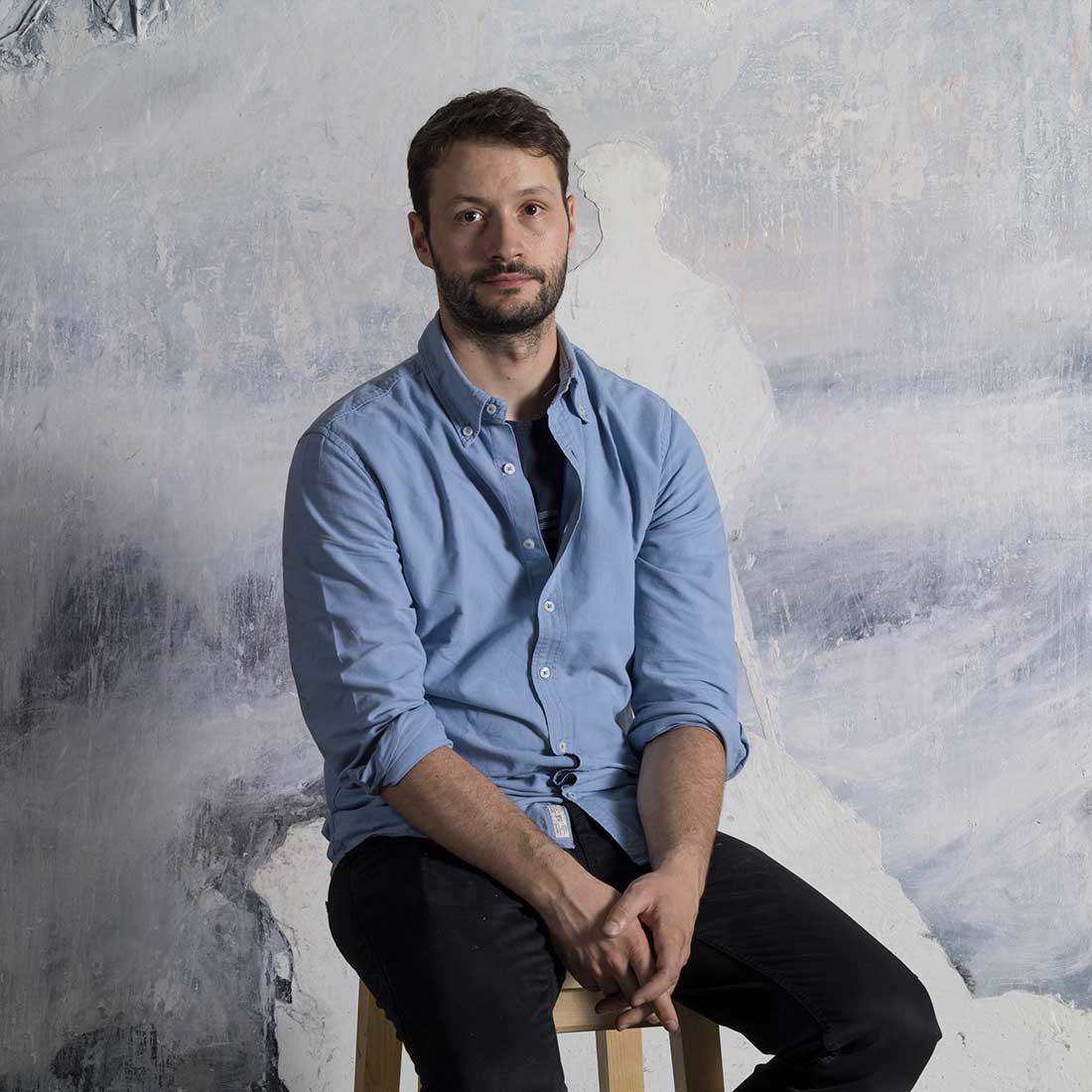
Jordi Diaz Alamà, born in Granollers in 1986, has a degree in Fine Arts from the University of Barcelona and is trained at the great international classical art schools such as the Florence Academy of Art (Italy), where he assimilates the techniques used by great figures. 19th-century painting. He consolidates his training with contemporary masters of realism, such as the Norwegian painter Odd Nerdrum, Guillermo Muñoz Vera, or Antonio López.
Alamà was the winner of the Figurativas ’11 Contest organized by the Fundación de las Artes y los Artistas in collaboration with the MEAM and the LI Ynglada-Guillot International Drawing Award organized by the Royal Catalan Academy of Fine Arts of Sant Jordi.

Red Studio series. 200 x 200 cm
Oil, enamel, and resin on canvas
Jordi Diaz Alamà © All rights reserved.
Alamà’s artistic outlook is also developed thanks to his teaching role at the Barcelona Academy of Art, which he founded in 2013. At the Academy, he develops, expands, and shares his knowledge of classical methods, along with the idea that they can be valued as a tool that helps the interpretation and artistic representation of today’s world.
His personal work involves an impressive display of pictorial resources with a refined technique free of mannerisms that responds to the canon of contemporary classical figuration, continually investigating new concepts and plasticity. In 2017, he produced his most monumental work to date with La Cruz del Jubilee, a commission for the Iglesia de los Dolores de Vic. In the series # ClásicosDesollados, he unites his relentless realistic technique with bursts of abstraction, cutting, tearing, and literally skinning the most iconic works of the great masters of painting, from Velázquez to Manet, to highlight his inherent modernity. His interpretation of Rembrandt’s The Night Watch, Nocturnal Performance: Requiem for Saskia, is in the permanent collection of the Can Framis museum in Barcelona.

Red Studio Series. 150 x 150 cm
Oil, enamel, and resin on canvas
Jordi Diaz Alamà © All rights reserved.
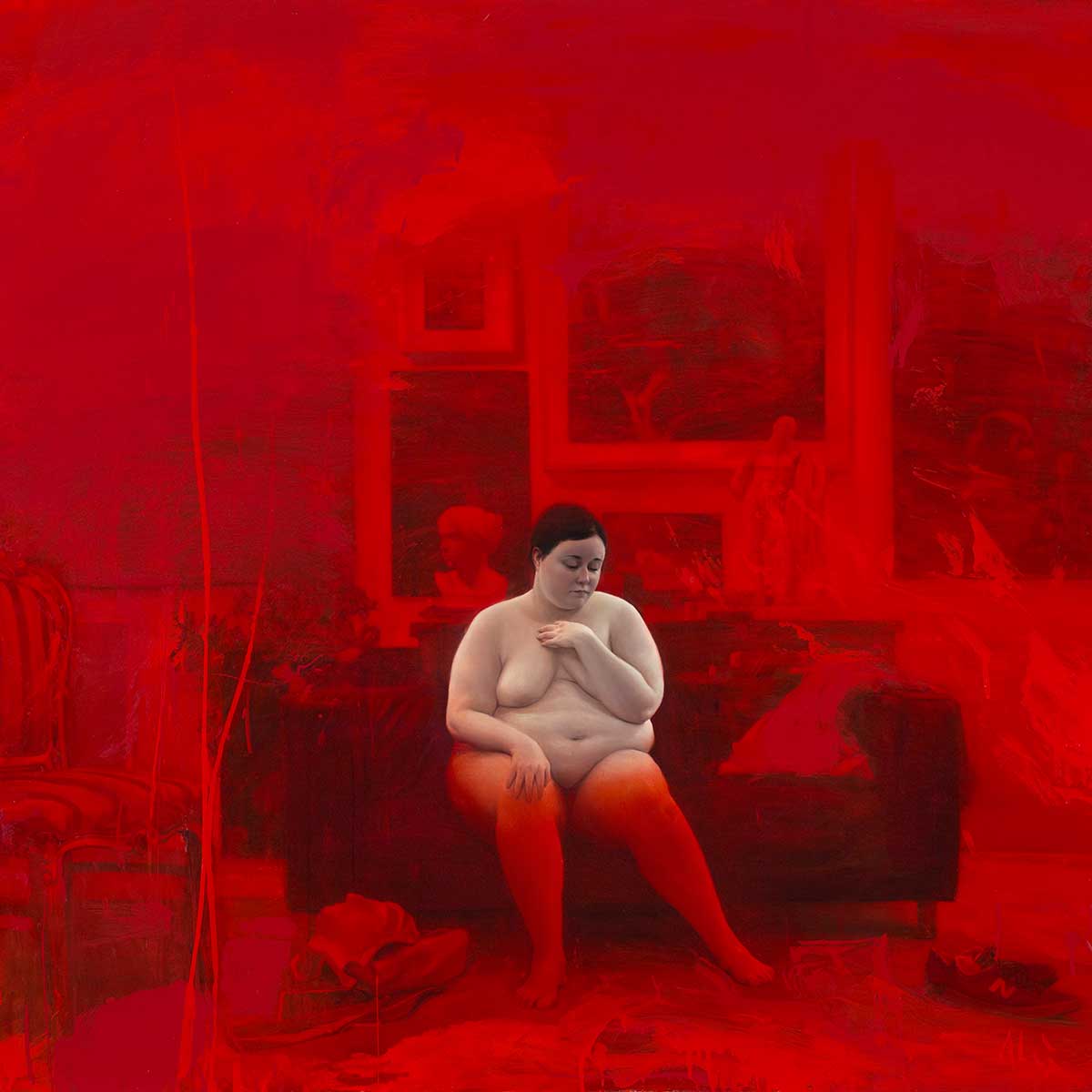
Red Studio Series. 94 x 94 cm
Oil, enamel, and resin on canvas
Jordi Diaz Alamà © All rights reserved.
Alamà’s is now facing a monument of universal history, anchored in collective memory, Dante Alighieri’s Divine Comedy. The exhibition project Si Volse a Retro, in collaboration with the sculptor Grzegorz Gwiazda, focuses on interpreting and illustrating the 33 songs that make up Hell, materializing Dante’s most impressive imagery and reaffirming his commitment to contemporary realistic figuration.
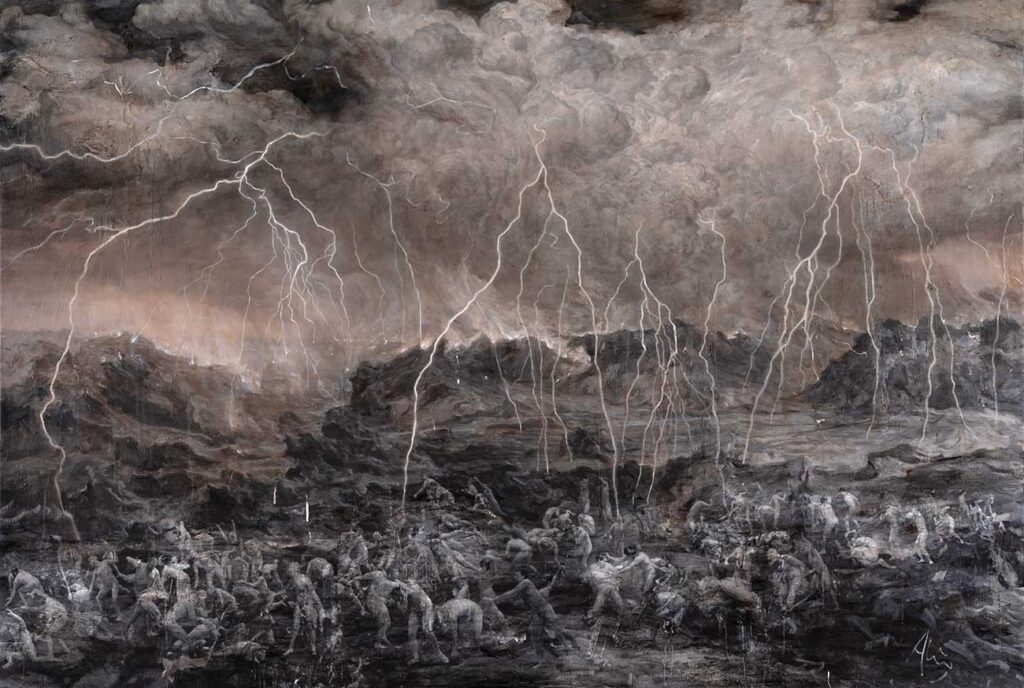
The Ruffians and Seducers
160 x 240 cm
Mixed media on canvas
Jordi Diaz Alamà © All rights reserved.
The Mysterious Heroic World of Jordi Diaz Alamà
An Exclusive Interview by Ariel SU
Artist/Painter | Director of
The Barcelona Academy of Art
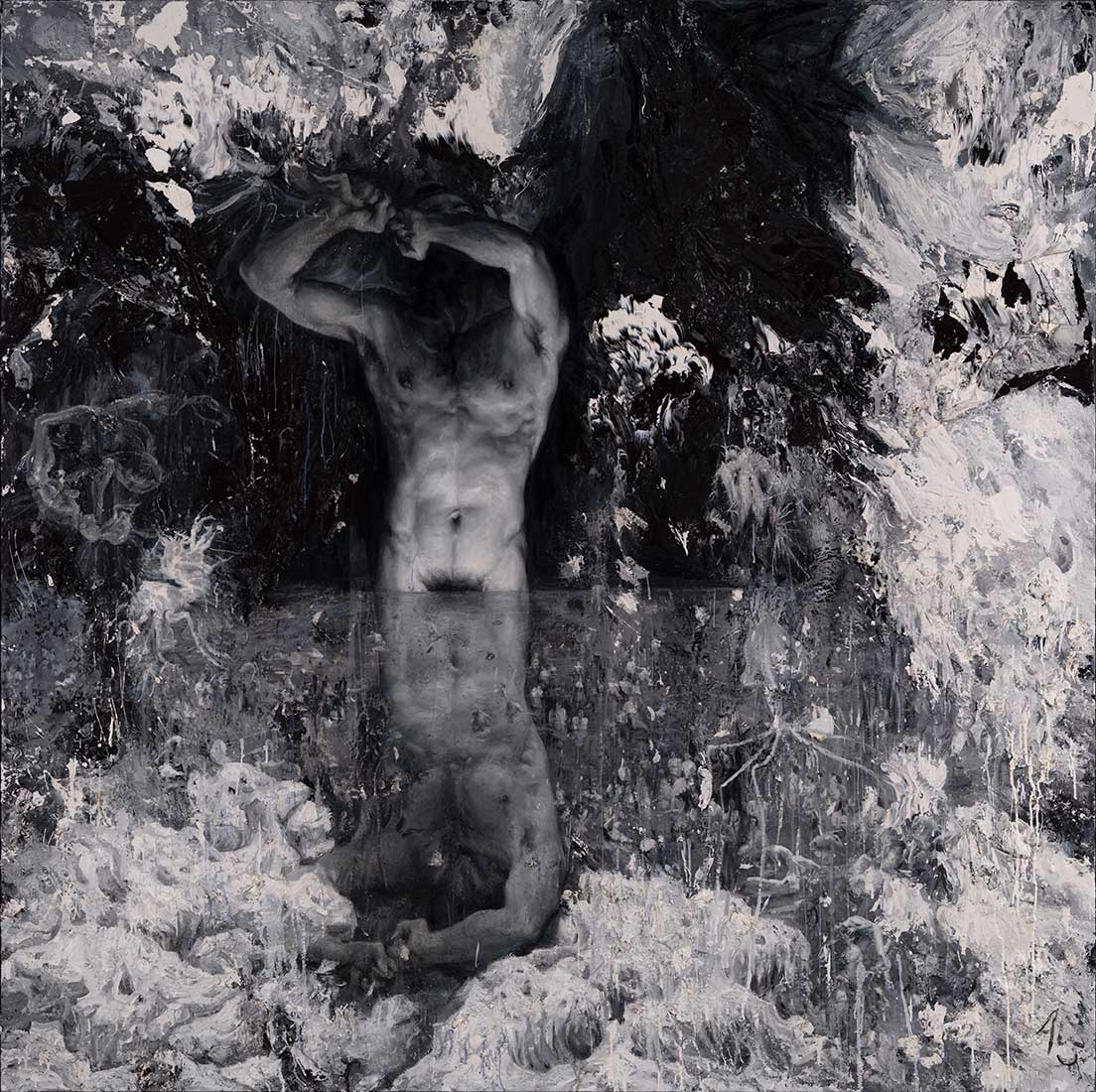
Lucifer. 200 x 200 cm
Mixed media on canvas
Jordi Diaz Alamà © All rights reserved.
Art Market Magazine:
We are delighted to present this interview, Jordi Diaz Alamà, and speak with you about your artistic journey, The Barcelona Academy of Art you founded in 2013, and your position as the head of the Academy. But first, let’s start with the beginning. What can you share with us about your childhood years? You grew up in Granollers, Catalonia, a city close to Barcelona. Were you exposed to an artistic atmosphere in the city where you grew up? Did you come from a creative family?
Jordi Diaz Alamà: Thank you for allowing me to share my story.
My interest in drawing began at a very young age, thanks to my uncle, who had a passion for creating comic strips. He was the first person to introduce me to the world of artistry, and I quickly became captivated by drawing and painting, envisioning it as a lifelong career. Although the rest of my family did not pursue creative fields, I was determined to follow my artistic path. Convincing them to support my aspirations was a challenge, but when I started my studies at the Fine Arts University in Barcelona, they became big supporters and have been since.
Growing up near Barcelona was a truly remarkable experience as it granted me access to the works of Spanish and international masters. Seeing these works in person greatly enriched my artistic perspective and fueled my passion to further explore the realm of art.
Art Market Magazine:
Your Academic Journey started at The University of Barcelona for Fine Arts, followed by studies at the Florence Academy of Art in Italy. What was the main emphasis during your studies in each institution, and what led you to develop your current artistic style based on the Renaissance Masters’ high technique combined with a contemporary abstract figurative approach?
J. D. A.: At the University of Barcelona, the prevailing focus leaned towards conceptual approaches to art. While intellectually stimulating, I found myself yearning for a more profound understanding of artistic techniques and a solid foundation that would enable me to paint and draw with greater freedom and precision. This thirst for knowledge made me look for more academic training, and it became evident that Florence, Italy, was the ideal destination to delve into the techniques of the Renaissance Masters.
Studying at the Florence Academy of Art was an enlightening experience that fundamentally transformed my artistic path. There, I immersed myself in the techniques of the Masters.
Later, I sought inspiration from contemporary realist painters whom I greatly admired, such as Odd Nerdrum in Norway and Antonio Lopez in Spain. Spending time in their studios gave me invaluable insights into the creative process and the essence of being an artist. The significance of discipline and the power of experimentation in artistic evolution left a mark on my artistic philosophy.
Art Market Magazine:
Where does the inspiration come from? Can you describe the entire process from the idea stage to the final result of the finished work? Do you plan the work from ahead and create drawings by hand or computer before painting?
J. D. A.: My inspiration primarily derives from literature and music, as they ignite my creativity. When I find myself deeply moved or captivated by a particular book or theme, I often plan a series of paintings around it. Working on multiple paintings simultaneously keeps my creative energy flowing and prevents monotony, allowing me to explore diverse aspects of the chosen theme. I prefer using live models for my initial compositions to begin the creative process. This approach enables me to capture the natural essence and emotions of the subjects. However, I also incorporate digital montages as part of my process. These digital compositions provide a broader perspective and allow me to envision the larger picture before I start working on the canvas.
The digital aspect becomes particularly crucial when I experiment with abstraction and color in my paintings.
By manipulating digital elements, I gain insights into how different colors and abstract elements can complement each other, enhancing my confidence when transitioning to the canvas.
Ultimately, my creative process involves a mix of traditional techniques, live models, and digital experimentation.
I think this approach empowers me to fully explore my vision and bring it to life in my finished works.

Mixed media on canvas
Jordi Diaz Alamà © All rights reserved.
Art Market Magazine:
In 2013, you founded the Barcelona Academy of Art, a significant step in your development, both from the artistic point of view and in the business managing aspect. Where does the courage come from? What advantages does the Academy add, and in which areas does the Academy focus? Did you discover a real need to open the Academy following your studies at the University of Fine Arts in Barcelona?
J. D. A.: Following my own academic journey and experience as a teacher at Barcelona University, I recognized a significant need in the artistic community for a structured and comprehensive learning environment. Many aspiring artists were yearning for a place where they could cultivate their artistic skills and receive proper guidance in drawing and painting techniques. Driven by the belief that a strong foundation in traditional art is essential for every artist, I gathered the courage to establish the Academy.
The Academy’s core focus lies in providing a complete curriculum emphasizing the fundamental skills of drawing (using pencil and charcoal) and painting (using oil). By imparting these traditional techniques, we empower our students to build a solid artistic groundwork and foster a deeper understanding of form, light, anatomy, and composition.
Establishing the Academy was a significant step in my personal and professional development. Witnessing the growth and accomplishments of our students fuels my passion for art and reinforces the value of providing a platform for aspiring artists to flourish.
Art Market Magazine:
Was it a long process to gain the recognition of a formal academic institute (B.A.ART degree ) from the Spanish government?
J. D. A.: While we have been actively working towards obtaining recognition for our programs as the first Figurative Arts Degree in Spain, the process has been ongoing, and we have encountered some delays, particularly due to the challenges posed by the pandemic. Despite the hurdles, we remain dedicated to fulfilling the requirements and standards the Spanish government sets to achieve formal academic institute status.
Art Market Magazine:
Are there also English studies for foreign students from different countries?
J. D. A.: Absolutely! The Barcelona Academy of Art prides itself on being an international school that welcomes students from all around the world.
As such, all our programs and courses are taught in English.
While the primary language of instruction is English, many of our teachers are either Spanish themselves or have become proficient in the language during their time at the Academy. As a result, they can also engage with students in Spanish, should they desire to do so.
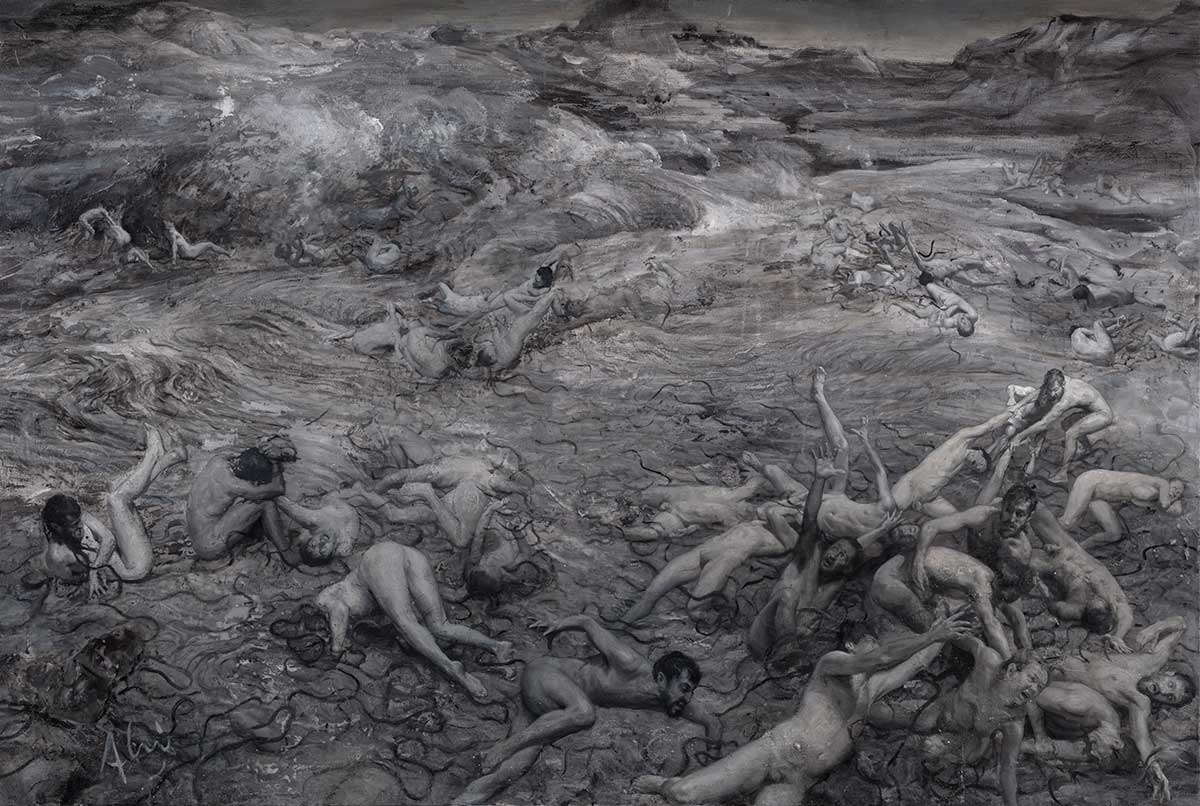
Lucifer. 200 x 200 cm
Mixed media on canvas
Jordi Diaz Alamà © All rights reserved.
Art Market Magazine:
What is your role at the Academy? Other than being the director, do you teach specific courses? What can you tell us about the teaching staff at the Academy? Would you like to mention the names of some of the leading professors?
J. D. A.: As the Director of the BAA, my primary role is to oversee the good functioning of the Academy, and I’m also teaching the advanced painting students.
It brings me immense joy to share my knowledge with them, and I also learn a lot from the students’ unique perspectives and creativity.
Our teaching staff comprises accomplished artists who have studied at academies like the BAA, enabling them to empathize with the students’ artistic journey and understand any challenges they may encounter.
This shared experience fosters a supportive and encouraging learning environment where students feel understood and motivated to excel.
The professors at the BAA are not only exceptional educators but also highly successful artists with active careers in the art world. They bring their expertise and experiences from their artistic endeavors into the classroom, inspiring and guiding students to reach their full potential as artists.
For more detailed information about our faculty and their personal work, I invite you to explore our website at academyofartbarcelona.com.
Art Market Magazine:
How would you describe the current state-of-the-art field in Barcelona? Is it live and developed? Do you see any specific issues which should be more invested and improved? (Museums / Exhibitions in galleries/economic support to artists from the government).
J. D. A.: Barcelona’s art scene is lively and varied, reflecting the city’s artistic heritage and modern creativity. It features a mix of traditional and contemporary art, with many artists, galleries, museums, and events contributing to its vibrant atmosphere. For instance, museums like MEAM (Museu Europeu d’Art Modern) actively promote figurative art, keeping the tradition of representational art alive.
The Catalonia government supports emerging artists through various public contests and initiatives, fostering a nurturing environment for young talents to thrive. However, while the government’s involvement is crucial, galleries also still have an essential role in supporting emerging artists. They can significantly impact an artist’s career trajectory by taking the initiative to bet on young talents and providing them with exhibition spaces and representation.
Art Market Magazine:
Let’s go back to discuss your latest projects. The ‘DIVINA COMEDIA’ is a series of artworks based on an eschatological poetic poem by Dante Alighieri written in the early 14th century. The dramatic works of art describe a journey through hell in light and shadow.
The heroic and dramatic expression is demonstrated remarkably. The characters are fascinating. Did you get inspiration from different artists for this project? For how long did you work on this project?
J. D. A.: The ‘DIVINA COMEDIA’ project was an immersive and personal endeavor for me. While I did draw inspiration from the works of various artists who had previously illustrated Dante’s poem, such as Doré and Barceló, I was committed to infusing the series with my unique artistic vision of Hell. Rather than creating a literal illustration of the poem, I intended to convey the emotional and psychological journey through hell, bringing forth my interpretation of the vivid characters and dramatic expressions described by Dante.
Completing the Inferno series was a challenging but rewarding two-year journey. The project’s duration was further impacted by the challenges posed by the pandemic, which affected all of us during the first confinement. The collective anguish and fear experienced during those times found their way into the creation of the tortured souls depicted in the artworks, evoking powerful emotions in the series.
Throughout the project, I had the privilege of working with various models, including friends and family, who were eager to participate in this artistic exploration. Their participation added a personal touch to the series, making it even more meaningful and memorable.
In the end, the Inferno series stands as a testament to the power of art to capture the human experience, emotions, and imagination. It was an introspective and transformative journey, and I am grateful for the opportunity to have brought my artistic vision of Dante’s Hell to life. Now I’m thrilled to embark on the next chapter of this series, exploring Purgatory.
It’s a new chance to experiment with new visual elements, colors, and compositions in this transition from darkness and suffering to hope and ascent.
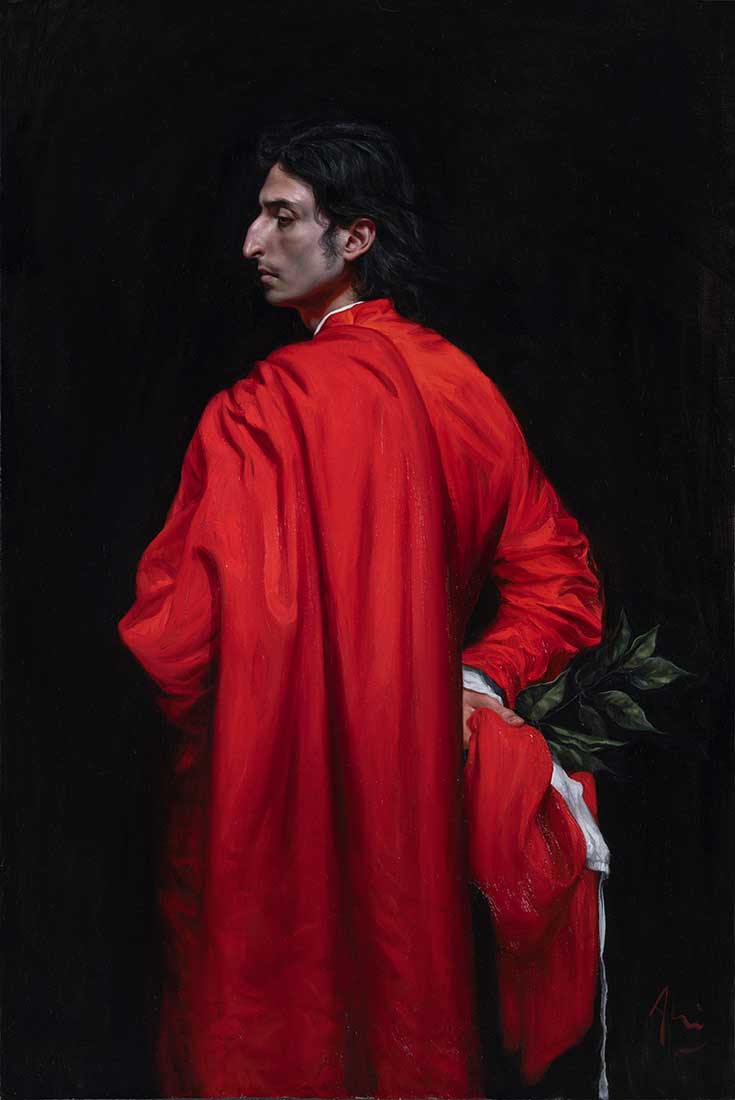
Si Volse a Retro. 134 x 89cm
Mixed media on canvas
Jordi Diaz Alamà © All rights reserved.
Art Market Magazine: What can you tell us about the upcoming exhibition featuring this project?
J. D. A.: The Inferno series is currently being showcased at an exhibition in Pedraza, Madrid, running until the 30th of July. Following this, the series will be exhibited at Les Bernardes in Salt, Girona, from September through December. Looking ahead, we have an exciting exhibition planned for next year at the Ujadowski Center in Warsaw. Hopefully, the series will keep on moving.
Art Market Magazine:
I was highly impressed by the Red Studio series after checking some of your past projects.
This magnificent project features life models and a vast plurality in sensuality. What is the philosophical meaning of the saturated, vivid, and imposing reds in the paintings?
J. D. A.: Thank you for your kind words! In addition to its connection with sensuality and human emotions, the color red also symbolizes the “hell” of the artist’s studio. The series was created simultaneously with the Inferno series, and this synchronicity was intentional. The red in these paintings embodies the intense emotions, struggles, and challenges that artists often face in their creative spaces. As a haven for artistic expression, the studio can also be a battleground where artists confront their inner demons. By infusing the series with this dual meaning of sensuality and the artist’s internal turmoil, I aim to provide a glimpse into the passionate and sometimes tumultuous world of artistic creation.
Art Market Magazine:
The fire of the Dantesque Hell and the La Divina Commedia influences you profoundly in most of your projects.
When and why have you become so drawn to this? Is it a personal search for the meaning of humanity, the dark sides of life, and the interpretation of death?
J. D. A.: The influence of Dante in my projects holds a personal significance for me. The struggle, redemption, and transformation themes resonate deeply with my artistic vision.
I think, in one way or another, all my projects are a personal exploration of the same existential questions that have fascinated artists throughout history: the complexities of humanity, the human condition, and our collective search for meaning.
Art Market Magazine:
From years of experience in art, What advice can you give the young artist aiming to develop and make a name worldwide?
J. D. A.: To young aspiring artists, I would first say to embrace discipline: developing as an artist requires dedication and consistency. Secondly, dare to experiment and not be afraid to explore new techniques, styles, and themes. Experimentation is key to discovering your unique artistic voice and pushing the boundaries of your creativity.
Building a strong artistic community is also very important. Art thrives when artists come together to support and inspire one another. Seek out local art communities, join art clubs, attend workshops, and connect with fellow artists. Participate in local exhibitions, art fairs, and events. This allows you to gain exposure, connect with potential buyers and collectors, and build a foundation for your artistic career.

The Barcelona Academy of Art
The Barcelona Academy of Art is a high-performance specialized center dedicated to teaching drawing, painting, and sculpture professionally.
With a comprehensive curriculum and teaching methods derived from the classical tradition and the precepts of realism, the BAA offers its students work plans based on the methods of the great academic studios of the 19th century. The painters Jean-León Gérôme, León Bonnat, and Carolus-Duran, whose revised philosophy and teaching methods are integrated into the BAA, are figures of reference, emphasizing the importance of the direct study of nature and the analysis of historical masters.
The Barcelona Academy of Art has a wide range of educational possibilities. Throughout the year, the intensive programs of Drawing – Painting, and Drawing – Sculpture are held, complemented by seminars, weekend classes, and special Easter Break and Summer courses that help students to deepen and perfect specific aspects of the processes, approaches, and techniques, hand in hand with the best professionals.
academyofartbarcelona.com @barcelona.academyofart
| www.diazalama.com | @alama_art
Read the full article in Art Market Magazine Issue #83

